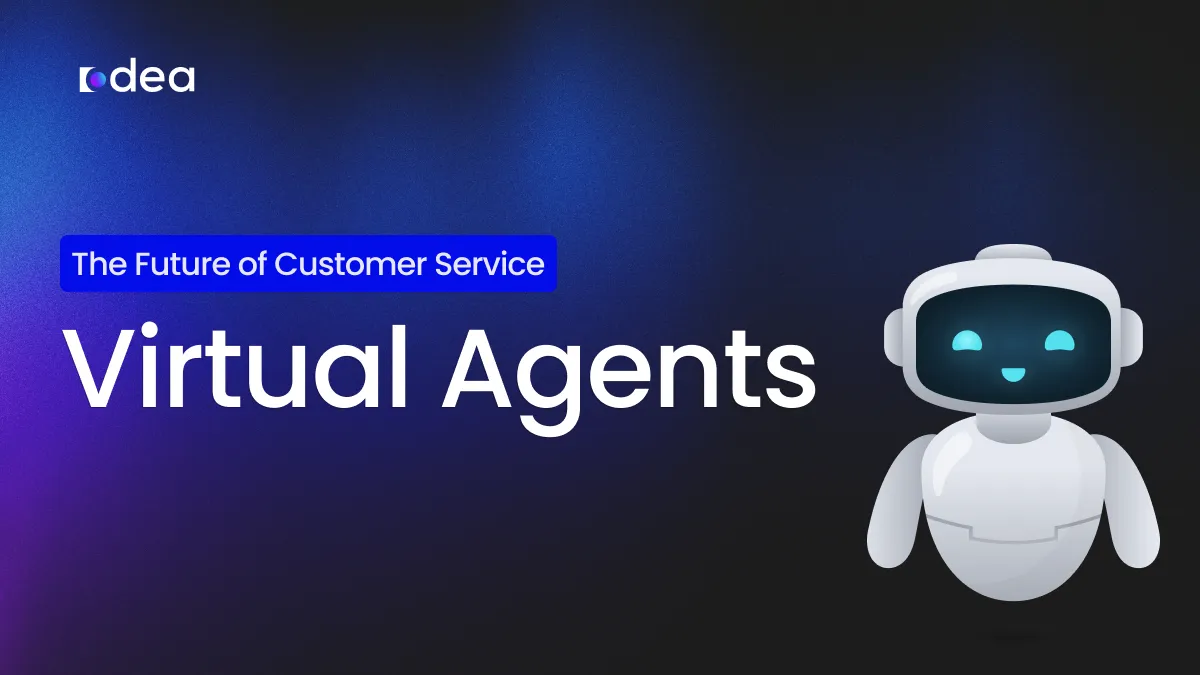In today’s fast-paced, customer-driven world, businesses are facing increased pressure to provide top-tier customer service, at a faster pace and with more personalized touch. Gone are the days when customers were willing to wait on hold for hours or get stuck in long email threads. Virtual agents are rapidly becoming the solution to these challenges, enabling businesses to scale their customer service operations efficiently, without compromising on quality.
With the rise of AI technologies, virtual agents are becoming more than just a futuristic idea—they’re a reality that can revolutionize how companies interact with their customers. AI-powered virtual agents use advanced Natural Language Processing (NLP) and machine learning to provide seamless, human-like interactions with customers, offering responses that feel intuitive and personalized.
This article delves deep into the role of virtual agents in customer service, how they are reshaping the industry, and why adopting them is no longer optional but a necessity for businesses that aim to stay competitive in the modern market.
What Are Virtual Agents?
At their core, virtual agents are AI-driven software solutions that are capable of communicating with customers, understanding their queries, and delivering appropriate responses across a variety of channels.
These agents are not limited to text-based communication—they can handle voice interactions, making them versatile enough to be used in call centers, chatbots, and interactive voice response systems (IVR).
The magic behind these virtual agents lies in their ability to simulate human-like conversations using AI algorithms that process natural language. Unlike traditional chatbots, which typically operate based on pre-programmed scripts, virtual agents use machine learning to improve over time, offering more accurate responses as they learn from past interactions.
This adaptive nature allows virtual agents to deliver a more personalized and efficient experience for customers, regardless of the volume of requests or the complexity of the issues they face.

How Virtual Agents Work
Virtual agents leverage several key technologies to perform their roles efficiently:
- Natural Language Processing (NLP): NLP allows virtual agents to understand and interpret human language—whether written or spoken. This technology enables the virtual agent to recognize the intent behind a customer’s words, process them, and provide relevant responses.
NLP also allows the agent to understand synonyms, context, and even emotions, ensuring that interactions feel more natural. - Machine Learning: Over time, virtual agents learn from every interaction they have. As they process more queries, they become better at predicting customer needs and offering more precise solutions.
The agent adapts based on its ongoing learning, ensuring that customers receive faster, more relevant support. - Speech Recognition and Text-to-Speech: Virtual agents can also engage in voice-based interactions. Through speech recognition, they can transcribe spoken words into text, understand the customer’s request, and respond through text-to-speech technology.
This ability makes virtual agents incredibly versatile, able to function in both text-based and voice-based environments. - Integration with Backend Systems: Virtual agents are not standalone systems—they are integrated with backend databases, CRMs (Customer Relationship Management), and other business systems.
This integration enables them to access real-time data, provide personalized responses, and handle complex queries, such as checking account balances or updating customer information.
By combining these technologies, virtual agents are able to offer efficient, real-time support across a wide range of industries.
To explore a real-world implementation of these AI-driven capabilities, check out how Amazon Connect enhances customer support using virtual agents and AI.
Benefits of Virtual Agents in Customer Service
Businesses are increasingly recognizing the value of virtual agents for their customer service operations. Here are some key benefits that businesses can leverage by implementing virtual agents:
- Cost Reduction: One of the primary reasons businesses adopt virtual agents is the significant cost savings they offer. Virtual agents can handle thousands of inquiries simultaneously without the need for additional staff, reducing the costs associated with hiring and training customer service agents.
Businesses can reallocate resources to more strategic areas while maintaining high-quality customer service at scale. - 24/7 Availability: Unlike human agents, virtual agents do not require breaks or rest. They can provide round-the-clock support to customers, ensuring that all inquiries are answered immediately.
This availability is especially crucial in industries such as e-commerce, travel, or finance, where customers might need assistance outside of regular business hours. - Scalability: Virtual agents are inherently scalable. Whether your business is dealing with a few customers queries a day or thousands of inquiries during a peak season, virtual agents can handle the load without any issues.
This scalability allows businesses to handle growing customer demands without having to constantly hire and train additional staff. - Consistency: Virtual agents provide consistent responses to customers. Unlike human agents who may vary in their tone or response depending on the time of day or workload, virtual agents always offer the same level of service.
This consistency helps build trust with customers and ensures that the service quality never dips. - Enhanced Customer Experience: Virtual agents offer faster response times, reducing wait times for customers. By handling simple or repetitive tasks, they allow human agents to focus on more complex inquiries, ensuring that customers receive quicker resolutions to their issues.
The personalized nature of virtual agents also contributes to a positive customer experience. - Improved Data Collection: Virtual agents collect valuable data during interactions, which can be used for analysis and improvement of customer service strategies.
This data can provide insights into customer behavior, common pain points, and emerging trends, enabling businesses to refine their products, services, and communication strategies.

How Virtual Agents Are Used Across Industries
Virtual agents are revolutionizing customer service in various industries. Here are a few examples of how different sectors are benefiting from this technology:
- E-commerce: Virtual agents are handling product inquiries, tracking orders, processing returns, and answering common customer questions. This automation not only improves efficiency but also enhances the customer’s shopping experience by providing quick responses and reducing the chances of abandoned carts.
To see how Odea Integrations is transforming e-commerce support and boosting retention and ROI, check out this in-depth case study: How Odea Integrations Revolutionize E-Commerce Customer Experiences (Boost Retention & ROI). - Banking & Finance: In the banking sector, virtual agents are used for account inquiries, transaction processing, fraud detection, and even financial advising. Customers can quickly check their account balances, transfer money, or inquire about their credit scores without having to wait in long queues.
- Healthcare: Virtual agents are transforming the healthcare industry by helping patients schedule appointments, refill prescriptions, and receive health reminders. They also serve as initial points of contact for patient inquiries, reducing the workload of medical staff and enabling them to focus on more critical tasks.
More advanced agents can verify patient identity, manage billing, and offer medication guidance—enabling faster, more personalized care. Learn more in this article. - Travel & Hospitality: From booking flights and hotels to providing travel recommendations, virtual agents are improving the customer experience in the travel industry. They can handle last-minute changes, provide information on destination details, and assist with cancellations and rescheduling.
- Telecommunications: Virtual agents in telecoms handle billing inquiries, technical support, and troubleshooting. This automated support saves time for both customers and service providers while ensuring that customers receive immediate assistance with their issues.

The Future of Customer Service: Virtual Agents Leading the Way
The future of customer service is clearly virtual agents. As businesses continue to embrace digital transformation, AI-powered virtual assistants will become even more integral to operations.
These agents will become smarter, more intuitive, and capable of managing even more complex customer interactions. They will also be able to integrate seamlessly with other technologies, like IoT and Blockchain, to provide an even richer experience for customers.
Businesses that embrace virtual agents now will be well-positioned for future success. They’ll have the infrastructure in place to scale quickly, offer superior customer service, and reduce costs at the same time.
By adopting these technologies, businesses can stay ahead of the competition and keep customers happy and loyal.
Conclusion
The benefits of virtual agents for customer service are undeniable. They offer cost savings, scalability, 24/7 availability, and enhanced customer satisfaction. As the technology evolves, virtual agents will only become more sophisticated, providing even more value to businesses and customers alike.
To stay competitive in the digital age, businesses must adopt AI-driven customer service solutions like virtual agents. Don’t wait—take action now to transform your customer service operations and deliver the kind of seamless, personalized support that today’s customers expect.
Ready to enhance your customer service with virtual agents? Start by exploring how this cutting-edge technology, powered by Odea Integration, can streamline your operations and boost customer satisfaction.
Contact us today to learn more about how Odea Integration can help you implement virtual agents in your business and take the first step toward revolutionizing your customer service approach.





